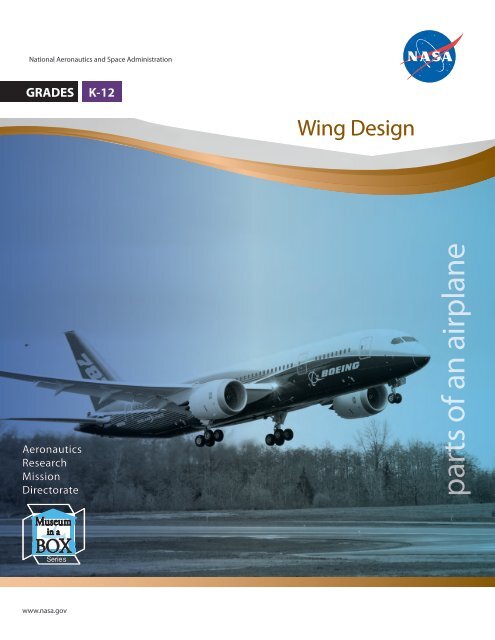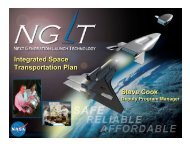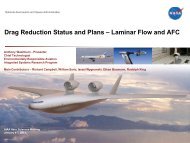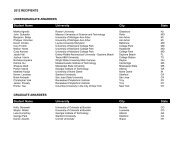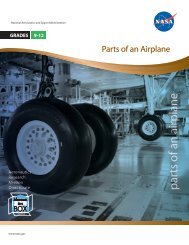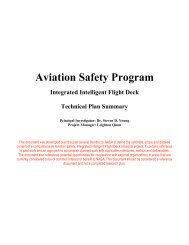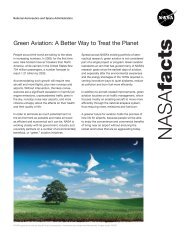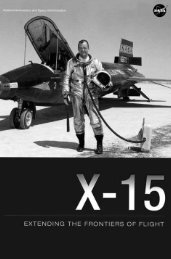Wing Design - NASA - NASA - Aeronautics Research Mission ...
Wing Design - NASA - NASA - Aeronautics Research Mission ...
Wing Design - NASA - NASA - Aeronautics Research Mission ...
You also want an ePaper? Increase the reach of your titles
YUMPU automatically turns print PDFs into web optimized ePapers that Google loves.
National <strong>Aeronautics</strong> and Space Administration<br />
GRADES<br />
<strong>Aeronautics</strong><br />
<strong>Research</strong><br />
<strong>Mission</strong><br />
Directorate<br />
Museum<br />
Museum<br />
in in a<br />
a<br />
BOX<br />
BOX<br />
Series<br />
www.nasa.gov<br />
K-12<br />
<strong>Wing</strong> <strong>Design</strong><br />
parts of an airplane
MUSEUM IN A BOX<br />
2<br />
<strong>Wing</strong> <strong>Design</strong><br />
Lesson Overview<br />
(Photo courtesy of <strong>NASA</strong> - www.nasaimages.org)<br />
In this lesson, students will learn about forces, motion, and properties of objects and materials through the concepts of<br />
basic wing design. They will begin by exploring birds’ wings and discovering the properties required for successful flight.<br />
Next they will move to basic aircraft wing shapes and finally, calculate some basic wing parameters.<br />
Objectives<br />
Students will:<br />
1. Discover how the feathers on diferent varieties of<br />
birds relate to their ability to fy.<br />
2. Learn how airplane wings are designed for specifc<br />
tasks and situations.<br />
3. Learn the basic math behind wing design.<br />
GRADES K-12<br />
parts of an airplane<br />
Materials:<br />
In the Box<br />
Ostrich Feather<br />
Turkey Feather<br />
Provided by User<br />
Ruler<br />
Time Requirements: 1 hour 10 minutes
Background<br />
<strong>Wing</strong> <strong>Design</strong><br />
<strong>Wing</strong> design is constantly evolving. If you were to compare<br />
the wing of the Wright Flyer (Img. 1) with that of a modern<br />
aircraft, such as the Boeing 787 (Img. 2), the diference is<br />
remarkable. The number of lifting surfaces, shape, size and<br />
materials used all contribute to an aircraft’s performance.<br />
Since the 1930’s, <strong>NASA</strong> and its predecessor NACA have been<br />
on the forefront of wing design, developing the basic airfoil<br />
shapes airplane manufacturers have used ever since to<br />
provide the lift component that is vital to air travel.<br />
Before a wing is designed, its mission has to be determined.<br />
What type of aircraft will this wing be attached to? Will it need<br />
to operate at high altitudes with thin atmospheres? Will it<br />
have to carry heavy loads? Will it need space to mount the<br />
engines? How much fuel will we want to store inside? How<br />
fast or agile will the aircraft need to be? The list of potential<br />
specifcations is long and highly complex.<br />
(Photo courtesy of Wikipedia, GNU Free Documentation License)<br />
(Photo courtesy of Boeing)<br />
The same type of design challenges can be seen in nature with our feathered friends, the birds. While all birds have<br />
wings, not every bird can fy. Take the ostrich (Img. 3) for example. It is a large bird, weighing on average nearly 200<br />
pounds, but its wings are short and its feathers are fufy and<br />
undefned. No matter how hard it tries, the wing will never be<br />
able to produce enough lift for the ostrich to fy.<br />
Img. 3 An ostrich with folded wings<br />
(Photo courtesy of Lost Tribe Media, Inc.)<br />
Img. 1 The 1903 Wright Flyer<br />
Img. 2 Boeing 787<br />
MUSEUM IN A BOX<br />
parts of an airplane 3
MUSEUM IN A BOX<br />
4<br />
The seagull (Img. 4) on the other hand is a small bird, weighing<br />
barely 2 pounds, but has long, thin wings which are perfect for<br />
gliding on the coastal breezes. It needs airfow over the wing to<br />
work though, so in order to fy the bird has to frst run forwards<br />
to increase the airfow over its wings, just as a plane would on<br />
the runway.<br />
The robin (Img. 5) uses a very diferent style of wing. To avoid<br />
predators such as cats, it needs to be able to jump quickly into<br />
the air and does so using short, fast moving wings that provide<br />
lots of lift, but at the sacrifce of forward speed.<br />
Lastly, some predatory birds, such as hawks, need the ability<br />
to fy quickly in order to catch their prey, but also need to carry<br />
the meal home to their ofspring. To achieve this, they are<br />
able to fold their wings back while diving, giving them a fast,<br />
sleek appearance for the attack, but a wide, large wingspan for<br />
carrying heavy loads on the journey home.<br />
parts of an airplane<br />
Img. 4 A seagull in fight<br />
((Photo courtesy of Arnold Paul, CC BY-SA 2.5 License)<br />
(Photo courtesy of Fauxpasgrapher, CC BY-NC-ND 3.0 License)<br />
Img. 5 A robin in fight
Compromises<br />
As with everything in life there are compromises and this is no diferent with wing design. While each design works<br />
well, they all have limitations or restrictions making them suitable only for certain tasks.<br />
Rectangular <strong>Wing</strong>: The rectangular wing, sometimes referred to as<br />
the “Hershey Bar” wing in reference to the candy bar it resembles, is<br />
a good general purpose wing. It can carry a reasonable load and fy<br />
at a reasonable speed, but does nothing superbly well. It is ideal for<br />
personal aircraft as it is easy to control in the air as well as inexpensive<br />
to build and maintain.<br />
Elliptical <strong>Wing</strong>: The elliptical wing is similar to the rectangular wing and<br />
was common on tail-wheel aircraft produced in the 1930s and 40s. It<br />
excels however in use on gliders, where its long wingspan can capture<br />
the wind currents easily, providing lift without the need for a lot of<br />
forward momentum, or airspeed.<br />
Swept <strong>Wing</strong>: The swept wing is the “go to” wing for jet powered aircraft.<br />
It needs more forward speed to produce lift than the rectangular wing,<br />
but produces much less drag in the process, meaning that the aircraft<br />
can fy faster. It also works well at the higher altitudes, which is where<br />
most jet aircraft fy.<br />
Delta <strong>Wing</strong>: The delta wing advances the swept wing concept, pulling<br />
the wings even further back and creating even less drag. The downside<br />
to this however is that the aircraft has to fy extremely fast for this wing<br />
to be efective. This is why it’s only found on supersonic aircraft (aircraft<br />
that fy faster than the speed of sound) such as fghter jets and the Space<br />
Shuttle orbiter. There were also two commercial passenger jets that<br />
used this wing design, the Russian TU-144 (Img. 6) and BOAC’s Concorde<br />
(Img. 7), both of which could cruise at supersonic speeds.<br />
MUSEUM IN A BOX<br />
parts of an airplane 5
MUSEUM IN A BOX<br />
6<br />
Img. 6 A Russian TU-144 Supersonic Passenger Jet<br />
Img. 7 The BOAC Concorde Supersonic Passenger Jet<br />
parts of an airplane<br />
(Photo courtesy of <strong>NASA</strong>)<br />
(Photo courtesy of Henrysalome & Wikipedia (GNU Free Documentation License))
<strong>Wing</strong> Construction & Mathematics<br />
The earliest wings were designed mostly through trial and error, using drawings and small scale models to test<br />
theories. Today though, we can precisely calculate a wing’s performance before it ever leaves the ground. Below are<br />
some terms related to wings and the mathematics behind wing design.<br />
Skin: The outer surface of the wing. Originally made of fabric, modern aircraft use aluminum or composite materials<br />
due to their lightweight and rust-resistant properties.<br />
Ribs & Stringers: These make up the inner skeleton of the wing, providing rigidity and strength. While strength is<br />
necessary, it is also important that the wing can fex slightly while it fies. This fexibility allows it to absorb the stress<br />
caused by turbulence and hard landings.<br />
BOX A IN<br />
Spar: The main center beam of the wing, designed to carry the structural loads and transfer them by attachment to<br />
MUSEUM<br />
the fuselage, or body, of<br />
the aircraft.<br />
Fuel Tank: Commonly<br />
located in the wing, fuel<br />
can either be housed in<br />
its own tank or allowed to<br />
fll the cavities between<br />
the ribs. In addition to<br />
powering the engines, the<br />
fuel adds rigidity to the<br />
wing.<br />
Root<br />
Fuel tank<br />
Slats<br />
Flaps: Are a “high lift /<br />
high drag” device. Not<br />
only do they improve the<br />
lifting ability of the wing<br />
Fig. 1 The components of a wing<br />
Stringers<br />
at slower speeds by changing the camber, or curvature of the wing, they also create more drag, meaning an aircraft can<br />
descend, or lose altitude faster, without gaining airspeed in the process.<br />
Root: The wing root is the portion of the wing that attaches to the fuselage, or body of the aircraft.<br />
<strong>Wing</strong> Tip: The wing tip is furthest from the fuselage and is typically where the navigation lights are mounted (a red<br />
light on the left, a green light on the right).<br />
Slats: Another “high lift” device typically found on swept or delta wing aircraft. Slats are similar to the faps except<br />
they are mounted on the leading edge of the wing. They also assist in changing the camber to improve lifting ability at<br />
slower speeds.<br />
Ribs<br />
Flap<br />
Spar<br />
Aileron<br />
<strong>Wing</strong> tip<br />
parts of an airplane 7
MUSEUM IN A BOX<br />
8<br />
<strong>Wing</strong> Construction & Mathematics (cont.)<br />
Aspect Ratio: The ratio of the wing’s length to its chord line. A wing with a high aspect ratio will perform well at<br />
slow speeds and produce large quantities of lift, but at the expense of maneuverability and airspeed. A wing with<br />
a low aspect ratio on the other hand will have a sleek appearance and allow an aircraft to fy faster, or be more<br />
maneuverable.<br />
Camber: The name given to the curvature of the upper or lower surfaces of the wing. A higher camber, or more<br />
curved surface, results in an aircraft that can fy at slower speeds while still generating sufcient lift for fight.<br />
Chord Line: The theoretical line running from the leading edge of the wing to the trailing edge.<br />
Leading Edge: The front edge of an aircraft’s wing.<br />
Trailing Edge: The rear edge of an aircraft’s wing.<br />
Leading Edge<br />
Fig. 2 <strong>Wing</strong> cross-section<br />
Chord Line<br />
Trailing Edge<br />
For additional information on wing design and aerodynamics, please refer to the Museum In A Box lessons<br />
“Four Forces” and “Bernoulli Principle”.<br />
parts of an airplane
Activity 1<br />
GRADES K-12<br />
Materials:<br />
In the Box<br />
Ostrich Feather<br />
Turkey Feather<br />
Provided by User<br />
None<br />
Worksheets<br />
Avian Feather<br />
Comparison<br />
(Worksheet 1)<br />
Reference Materials<br />
Img. 8 Turkey<br />
Img. 9 Ostrich<br />
Key Terms:<br />
None<br />
Avian <strong>Wing</strong> Comparison<br />
Time Requirement: 20 minutes<br />
Objective:<br />
In this activity, students will discover how the feathers on different species of birds relate<br />
to their ability to fly.<br />
Activity Overview:<br />
Students will compare the feather characteristics of both flying and non-flying birds and<br />
determine how the design of the feather correlates to the ability of the bird to fly.<br />
Activity:<br />
1. Begin by discussing with the students the<br />
Background information provided.<br />
2. Pass around each of the feathers and<br />
their associated images while asking the<br />
students to determine which feather<br />
came from which bird.<br />
3. Have the students list the characteristics<br />
of both the bird and the feather on their<br />
worksheets.<br />
Note: Your students’ answers may<br />
vary depending on the feathers included in<br />
the kit.<br />
4. Finally, have the students “fap” the<br />
feather in the air, using the same motion<br />
that a bird does fapping its wings. Ask<br />
them to describe its reaction to the wind<br />
and record it on their worksheets.<br />
Img. 8 Turkey<br />
Img. 9 Ostrich<br />
(Photo courtesy of the United States<br />
Department of Agriculture)<br />
(Photo courtesy of Kwolana & Wikipedia –<br />
GNU Free Documentation License)<br />
MUSEUM IN A BOX<br />
parts of an airplane 9
MUSEUM IN A BOX<br />
10<br />
Discussion Points:<br />
parts of an airplane<br />
1. Based upon your observations, why do you think the ostrich cannot fy, yet<br />
the turkey can?<br />
It should be noticed that the ostrich feather isn’t very good at catching the air. It<br />
has very little resistance, which means it cannot produce much lift. This is because<br />
of the large gaps between each hair on the wing. Also, the ostrich’s wings are<br />
much shorter than the turkey’s in comparison to the weight of the bird, meaning<br />
that the wing would have to work much harder in order to produce lift.<br />
2. What makes the turkey wing more efcient at fight?<br />
The turkey wing has the appearance of a solid surface, just like an airplane’s wing.<br />
This makes it much more efcient at producing lift. Also, the bone at the center of<br />
each feather is hollow, making it lighter and therefore requiring less energy for the<br />
bird to become airborne.<br />
3. Using what we have learned about bird wings, what can we infer about the<br />
wings of an airplane?<br />
Generically speaking, long, thin wings that are light in weight will produce the<br />
most lift. It is important to note though that there is no single “best wing” solution.<br />
Each wing is designed specifcally for the aircraft intended for use. While both<br />
turkeys and sparrows can fy, a turkey couldn’t use a sparrow’s wings to become<br />
airborne; they are simply too short to support the turkey’s weight. The same is true<br />
for the wings of diferent aircraft. Activity Two discusses this in more detail.
NATIONAL SCIENCE STANDARDS K-4<br />
SCIENCE AS INQUIRY<br />
• Abilities necessary to do scientifc inquiry<br />
• Understanding about scientifc inquiry<br />
PHYSICAL SCIENCE<br />
• Property of objects and materials<br />
SCIENCE AND TECHNOLOGY<br />
• Abilities of technological design<br />
• Understanding about science and technology<br />
NATIONAL SCIENCE STANDARDS 5-8<br />
SCIENCE AS INQUIRY<br />
• Abilities necessary to do scientifc inquiry<br />
• Understandings about scientifc inquiry<br />
PHYSICAL SCIENCE<br />
• Properties and changes of properties in matter<br />
SCIENCE AND TECHNOLOGY<br />
• Abilities of technological design<br />
• Understanding about science and technology<br />
NATIONAL SCIENCE STANDARDS 9-12<br />
SCIENCE AS INQUIRY<br />
• Abilities necessary to do scientifc inquiry<br />
• Understandings about scientifc inquiry<br />
PHYSICAL SCIENCE<br />
• Structure and properties of matter<br />
• Interactions of energy and matter<br />
SCIENCE AND TECHNOLOGY<br />
• Abilities of technological design<br />
• Understanding about science and technology<br />
MUSEUM IN A BOX<br />
parts of an airplane 11
MUSEUM IN A BOX<br />
Activity 2<br />
GRADES K-12<br />
Materials:<br />
In the Box<br />
None<br />
Provided by User<br />
None<br />
Worksheets<br />
<strong>Wing</strong> <strong>Design</strong>s<br />
(Worksheet 2)<br />
Reference Materials<br />
Img. 10 Lockheed Martin<br />
F-22 “Raptor”<br />
Img. 11 Cessna<br />
T-37 “Tweet”<br />
Img. 12 McDonald<br />
Douglas KC-10 “Extender”<br />
Img. 13 Lockheed Martin/<br />
<strong>NASA</strong> ER-2<br />
4 Planform Silhouettes<br />
Fig. 3 Lockheed Martin<br />
F-22 “Raptor”<br />
Fig. 4 Cessna T-37 “Tweet”<br />
Fig. 5 McDonald Douglas<br />
KC-10 “Extender”<br />
Fig. 6 Lockheed Martin/<br />
<strong>NASA</strong> ER-2<br />
Key Terms:<br />
None<br />
Airplane <strong>Wing</strong> <strong>Design</strong><br />
Time Requirement: 20 minutes<br />
Objective:<br />
In this activity, students will learn how airplane wings are designed for specific<br />
tasks and situations.<br />
Activity Overview:<br />
Students will compare the outline of a variety of airplane wings and determine<br />
how each can be used to perform specific tasks.<br />
Activity:<br />
1. If you have not performed Activity 1 - Avian <strong>Wing</strong> Comparison, review<br />
the background information with the students prior to completing this<br />
activity.<br />
Img. 10 Lockheed Martin F-22 “Raptor”<br />
parts of an airplane<br />
12<br />
2. Show the students each of the four images below and ask them to<br />
describe the type of plane and what purpose it serves.<br />
• Lockheed Martin F-22 “Raptor”: A fghter aircraft, designed to be fast and highly maneuverable.<br />
• Cessna T-37 “ Tweet”: A training aircraft for new military pilots.<br />
• McDonald Douglas KC-10 “ Extender”: A transport category aircraft, designed to carry heavy<br />
loads long distances.<br />
• Lockheed Martin/<strong>NASA</strong> ER-2: A very high-altitude surveillance plane.<br />
(Photo courtesy of the United States Air Force)
Img. 11 Cessna T-37 “Tweet”<br />
Img. 12 McDonald Douglas KC-10 “Extender”<br />
Img. 13 Lockheed Martin/<strong>NASA</strong> ER-2<br />
(Photo courtesy of the United States Air Force)<br />
(Photo courtesy of the United States Air Force)<br />
(Photo courtesy of <strong>NASA</strong>)<br />
MUSEUM IN A BOX<br />
parts of an airplane 13
MUSEUM IN A BOX<br />
14<br />
3. Show the students each of the planform silhouettes and ask them to<br />
describe the type of plane it would likely be attached to and what purpose<br />
it might serve.<br />
The silhouettes are in the same order as above. The purpose of this step is to<br />
highlight the specifc diferences in each wing so the students can correlate how<br />
a shape of wing is directly related to the type of aircraft it serves.<br />
4. Give each student a copy of the <strong>Wing</strong> <strong>Design</strong>s worksheet and discuss the<br />
differences between each design.<br />
Rectangular <strong>Wing</strong>: A rectangular wing is used on slower aircraft, typically training<br />
aircraft. It is somewhat maneuverable but allows for a high margin of pilot error. It<br />
also produces a large amount of lift so that the wing can be smaller in comparison to<br />
the body of the aircraft.<br />
Elliptical <strong>Wing</strong>: An elliptical wing is similar to the rectangular wing but is usually<br />
lighter and generates much more lift. It is often found on gliders and ultra-light<br />
aircraft.<br />
Swept <strong>Wing</strong>: Swept wings are usually found on jet aircraft. The thinner profile<br />
produces less drag, meaning it can fly at faster speeds. It is also much more<br />
maneuverable. These aircraft are less capable of flying at slow speeds however, so<br />
most swept wings are fitted with additional devices such as flaps or slats to assist in<br />
producing lift at low speeds.<br />
Delta <strong>Wing</strong>: The delta wing is used on very high speed (supersonic) aircraft, which<br />
are extremely maneuverable but much harder to control at slower speeds. As with the<br />
swept wing, they are also fitted with additional components to assist at slower speeds.<br />
Discussion Points:<br />
parts of an airplane<br />
1. If you had to design a wing for an airplane, what are some of the questions you<br />
might ask?<br />
While this question is very vague, it is designed to elicit further discussion on the factors<br />
behind wing design. For example, is the aircraft required to be fast and maneuverable,<br />
or does it have to carry a lot of weight? Is it being operated by skilled pilots or by newer,<br />
less experienced ones? Refer to the Background information for additional insight.<br />
2. Why is there not one “standard” wing that will work in all cases?<br />
An unfortunate part of wing design is that what makes one wing great in certain areas<br />
makes it terrible in others. For example, the delta wing is extremely maneuverable,<br />
allowing the plane to perform quick, tight turns, but because it is so short, it requires<br />
a much higher airspeed to work. This prohibits it from being used on slower, propeller<br />
powered aircraft. The rectangular wing could work on all aircraft, but because of its<br />
size and shape, would restrict the speed at which an aircraft could travel. This makes it<br />
a poor choice for jet aircraft, which are designed to operate at much higher speeds.
Fig. 3 Lockheed Martin F-22 “Raptor” Planform Silhouette<br />
Fig. 4 Cessna T-37 “Tweet” Planform Silhouette<br />
Fig. 5 McDonald Douglas KC-10 “Extender” Planform Silhouette<br />
MUSEUM IN A BOX<br />
Fig. 6 Lockheed Martin/<strong>NASA</strong> ER-2 Planform Silhouette<br />
parts of an airplane 15
MUSEUM IN A BOX<br />
16<br />
NATIONAL SCIENCE STANDARDS K-4<br />
SCIENCE AS INQUIRY<br />
• Abilities necessary to do scientifc inquiry<br />
• Understanding about scientifc inquiry<br />
PHYSICAL SCIENCE<br />
• Property of objects and materials<br />
SCIENCE AND TECHNOLOGY<br />
• Abilities of technological design<br />
• Understanding about science and technology<br />
NATIONAL SCIENCE STANDARDS 5-8<br />
SCIENCE AS INQUIRY<br />
• Abilities necessary to do scientifc inquiry<br />
• Understandings about scientifc inquiry<br />
PHYSICAL SCIENCE<br />
• Properties and changes of properties in matter<br />
SCIENCE AND TECHNOLOGY<br />
• Abilities of technological design<br />
• Understanding about science and technology<br />
NATIONAL SCIENCE STANDARDS 9-12<br />
SCIENCE AS INQUIRY<br />
• Abilities necessary to do scientifc inquiry<br />
• Understandings about scientifc inquiry<br />
PHYSICAL SCIENCE<br />
• Structure and properties of matter<br />
• Interactions of energy and matter<br />
SCIENCE AND TECHNOLOGY<br />
• Abilities of technological design<br />
• Understanding about science and technology<br />
parts of an airplane
Activity 3<br />
GRADES 9-12<br />
Materials:<br />
In the Box<br />
None<br />
Provided by User<br />
Metric ruler<br />
Worksheets<br />
<strong>Wing</strong> Math<br />
(Worksheet 3)<br />
Reference Materials<br />
None<br />
Key Terms:<br />
None<br />
<strong>Wing</strong> Math<br />
Time Requirement: 30 minutes<br />
Objective:<br />
In this activity, students will be exposed to and practice some of the math skills<br />
used in wing design.<br />
Activity Overview:<br />
Students will calculate the surface area, chord and aspect ratio of different wings<br />
to determine how they relate to the speed, maneuverability and performance of<br />
a wing.<br />
Activity:<br />
1. If necessary, complete Activity 2 – <strong>Wing</strong> <strong>Design</strong> with the students prior to<br />
completing this activity. This will provide a better understanding of how<br />
wings are designed.<br />
MUSEUM IN A BOX<br />
parts of an airplane 17
MUSEUM IN A BOX<br />
Y = 2.5cm<br />
18<br />
Plane #1<br />
X = 7.2cm<br />
parts of an airplane<br />
2. Using the <strong>Wing</strong> Math worksheet, work through the first problem with<br />
your students. Students should use a ruler to measure lines as needed.<br />
a. Calculate the surface area of one wing.<br />
Multiply the length by the height.<br />
Surface Area = 7.2cm • 2.5cm = 18cm<br />
Mean Chord<br />
Aspect Ratio =<br />
Length<br />
b. Calculate the length of the mean chord.<br />
The mean chord is equal to the height of the wing.<br />
Mean Chord = 2.5cm<br />
c. Calculate the wing’s aspect ratio.<br />
Divide the mean chord by the length.<br />
2.5cm<br />
Aspect Ratio =<br />
7.2cm<br />
= 0.35<br />
Surface Area of a Rectangle = Length x Height
Y = 4.1cm<br />
Plane #2<br />
3. Have the students complete the remaining problems on the worksheet<br />
individually or in groups.<br />
X = 8cm<br />
a. Calculate the surface area of one wing.<br />
Multiply the length by the height, then divide by 2.<br />
1<br />
Surface Area = (8cm • 4.1cm) = 16.4cm<br />
2<br />
Mean Chord<br />
Aspect Ratio =<br />
Length<br />
b. Calculate the length of the mean chord.<br />
The mean chord is equal to one half of the height of the wing.<br />
Mean Chord = 2.05cm<br />
c. Calculate the wing’s aspect ratio.<br />
Divide the mean chord by the length.<br />
Aspect Ratio =<br />
2.05cm<br />
8cm<br />
= 0.26<br />
Surface Area of a Right Triangle = 1 (Length x Height)<br />
2<br />
MUSEUM IN A BOX<br />
parts of an airplane 19
MUSEUM IN A BOX<br />
20<br />
Y = 3.3cm<br />
Z = 0.7cm<br />
Plane #3<br />
X = 7cm<br />
parts of an airplane<br />
Mean Chord<br />
Aspect Ratio =<br />
Length<br />
Surface Area of a Rectangle = Length x Height<br />
Surface Area of a Right Triangle = 1 (Length x Height)<br />
2<br />
a. Calculate the surface area of one wing.<br />
Seperate the wing into a right triangle and a rectangle. Calculate the area of each<br />
shape, then add them together.<br />
1<br />
Surface Area = (7cm • 0.7cm) + (7cm • 3.3cm) = 4.9cm + 11.55cm = 16.45cm<br />
2<br />
b. Calculate the length of the mean chord.<br />
Find the average between the length of the wing’s root (y+z) and the length of the wing’s tip (z).<br />
Mean Chord = (3.3cm + 0.7cm) + 0.7cm = 2.35cm<br />
2<br />
c. Calculate the wing’s aspect ratio.<br />
Divide the mean chord by the length.<br />
2.5cm<br />
Aspect Ratio = = 0.34<br />
7cm
X = 5.9cm<br />
Y = 4.9cm<br />
Z = 1.5cm<br />
a = 0.7cm<br />
b = 3.4 cm<br />
Plane #4<br />
b<br />
Q<br />
a<br />
Mean Chord<br />
Aspect Ratio =<br />
Length<br />
Surface Area of a Rectangle = Length x Height<br />
Surface Area of a Right Triangle = 1 (Length x Height)<br />
2<br />
P<br />
a. Calculate the surface area of one wing.<br />
(Surface Area of Triangle P) + (Surface Area of Triangle Q) + (Surface Area of Rectangle R)<br />
b.<br />
1<br />
2<br />
1<br />
2<br />
Surface Area = ( (5.9cm • 4.9cm)) + ( (0.7cm • 3.4cm)) + (5.9cm • 1.5cm) = 24.45cm<br />
Calculate the wing’s aspect ratio.<br />
When the mean chord’s length is unknown, divide the wing’s surface area by the square of the<br />
wingspan (the longest part of the wing’s length; in this case, a + x).<br />
Surface Area<br />
Aspect Ratio = = = 0.56<br />
Length 2<br />
24.45cm<br />
(0.7cm + 5.9cm) 2<br />
c. Determine the length of the mean chord.<br />
Mean Chord<br />
Use the formula Aspect Ratio = to calculate the length of the mean chord.<br />
Length<br />
Multiply the length of the longest part of the wing by the aspect ratio.<br />
Mean Chord = Length • Aspect Ratio = (0.7cm + 5.9cm) • 0.56 = 3.7cm<br />
R<br />
Z<br />
Y<br />
X<br />
MUSEUM IN A BOX<br />
parts of an airplane 21
MUSEUM IN A BOX<br />
22<br />
Plane #5<br />
parts of an airplane<br />
K = 2.4cm<br />
J = 1.3cm<br />
A<br />
Mean Chord<br />
Aspect Ratio =<br />
Length<br />
Surface Area of a Right Triangle =<br />
2<br />
1 (Length x Height)<br />
4.4cm<br />
X = 8.8cm<br />
4.4cm<br />
Length = 9.2cm<br />
Area of Triangle A = Area of Triangle B<br />
Y = 3.8cm<br />
a. Calculate the surface area of one wing.<br />
Because Triangle A = Triangle B, the surface area of this wing is the area of the<br />
triangle with base X and height Y. Multiply the length by the height, then divide by 2.<br />
1<br />
2<br />
Surface Area = (8.8cm • 3.8cm) = 16.72cm<br />
b. Calculate the length of the mean chord.<br />
The mean chord is equal to one half of the height of the wing.<br />
Mean Chord = 2.4cm + 1.3cm = 1.85cm<br />
2<br />
c. Calculate the wing’s aspect ratio.<br />
Divide the mean chord by the length.<br />
1.85cm<br />
Aspect Ratio = = 0.2<br />
9.2cm<br />
B<br />
J = 1.3cm
Discussion Points:<br />
1. What benefit does calculating the aspect ratio provide when designing a wing?<br />
The aspect ratio directly relates to the ability of the wing to provide lift. <strong>Wing</strong>s with<br />
higher aspect ratios will produce a lot of lift at fairly slow speeds but in turn produce a<br />
lot of drag, which equates to a slower overall aircraft.<br />
2. If you had to design a rectangular wing with an aspect ratio of 8.5, but were<br />
limited to a total wingspan of 40 meters, what distance would the chord line be?<br />
40m = 4.71m<br />
8.5<br />
3. After building the wing from #2 above, you discovered the aircraft couldn’t fly<br />
fast enough to produce sufficient lift to fly. What could be done to improve the<br />
wing’s lift-producing qualities?<br />
By increasing the camber, or curvature of the upper surface of the wing, you can<br />
increase the amount of lift a wing can produce. This also causes additional drag<br />
however, so the maximum speed of the aircraft (in flight) is reduced proportionately.<br />
MUSEUM IN A BOX<br />
parts of an airplane 23
MUSEUM IN A BOX<br />
24<br />
NATIONAL SCIENCE<br />
STANDARDS K-4<br />
SCIENCE AS INQUIRY<br />
• Abilities necessary to do scientifc inquiry<br />
• Understanding about scientifc inquiry<br />
PHYSICAL SCIENCE<br />
• Property of objects and materials<br />
SCIENCE AND TECHNOLOGY<br />
• Abilities of technological design<br />
• Understanding about science and technology<br />
NATIONAL SCIENCE<br />
STANDARDS 5-8<br />
SCIENCE AS INQUIRY<br />
• Abilities necessary to do scientifc inquiry<br />
• Understandings about scientifc inquiry<br />
PHYSICAL SCIENCE<br />
• Properties and changes of properties in matter<br />
SCIENCE AND TECHNOLOGY<br />
• Abilities of technological design<br />
• Understanding about science and technology<br />
NATIONAL SCIENCE<br />
STANDARDS 9-12<br />
SCIENCE AS INQUIRY<br />
• Abilities necessary to do scientifc inquiry<br />
• Understandings about scientifc inquiry<br />
PHYSICAL SCIENCE<br />
• Structure and properties of matter<br />
• Interactions of energy and matter<br />
SCIENCE AND TECHNOLOGY<br />
• Abilities of technological design<br />
• Understanding about science and technology<br />
parts of an airplane<br />
NATIONAL MATH<br />
STANDARDS K-12<br />
NUMBER AND OPERATIONS<br />
• Understand numbers, ways of representing numbers,<br />
relationships among numbers, and number systems<br />
• Understand meanings of operations and how they relate to one<br />
another<br />
• Compute fluently and make reasonable estimates<br />
ALGEBRA<br />
• Represent and analyze mathematical situations and structures<br />
using algebraic symbols<br />
• Use mathematical models to represent and understand<br />
quantitative relationships<br />
MEASUREMENT<br />
• Understand measurable attributes of objects and the units,<br />
systems, and processes of measurement<br />
• Apply appropriate techniques, tools, and formulas to determine<br />
measurements.<br />
DATA ANALYSIS AND PROBABILITY<br />
• Formulate questions that can be addressed with data and<br />
collect, organize, and display relevant data to answer them<br />
PROCESS<br />
• Problem Solving<br />
• Communication<br />
• Connections<br />
• Representation
Reference Materials
Fig. 1 The components of a wing<br />
Stringers<br />
<strong>Wing</strong> tip<br />
Ribs<br />
Slats<br />
Aileron<br />
Fuel tank<br />
Spar<br />
Flap<br />
Root
Fig. 2 <strong>Wing</strong> cross-section<br />
Trailing Edge<br />
Leading Edge<br />
Chord Line
Fig. 3 Lockheed Martin F-22 “Raptor” Planform Silhouette
Fig. 4 Cessna T-37 “Tweet” Planform Silhouette
Fig. 5 McDonald Douglas KC-10 “Extender” Planform Silhouette
Fig. 6 Lockheed Martin/<strong>NASA</strong> ER-2 Planform Silhouette
Student Worksheets
MUSEUM IN A BOX<br />
34<br />
Worksheet 1 Avian Feather Comparison<br />
Turkey Feather Ostrich Feather
Worksheet 2<br />
<strong>Wing</strong> <strong>Design</strong>s<br />
Rectangular <strong>Wing</strong> Elliptical <strong>Wing</strong><br />
Notes: Notes:<br />
Swept <strong>Wing</strong> Delta <strong>Wing</strong><br />
Notes: Notes:<br />
MUSEUM IN A BOX<br />
35
MUSEUM IN A BOX<br />
36<br />
Worksheet 3 <strong>Wing</strong> Math<br />
Plane #1<br />
Surface Area =<br />
Mean Chord =<br />
Aspect Ratio =<br />
Surface Area of a Rectangle = Length x Height<br />
Aspect Ratio =<br />
Y<br />
Mean Chord =<br />
Length X<br />
X<br />
Y
Worksheet 3 (cont.) <strong>Wing</strong> Math<br />
Plane #2<br />
Y<br />
Surface Area =<br />
Mean Chord =<br />
Aspect Ratio =<br />
X<br />
Surface Area of a Right Triangle = 1 (Length x Height)<br />
2<br />
Y<br />
Aspect Ratio = Mean Chord =<br />
Length X<br />
MUSEUM IN A BOX<br />
37
MUSEUM IN A BOX<br />
38<br />
Worksheet 3 (cont.) <strong>Wing</strong> Math Surface Area of a Rectangle = Length x Height<br />
Y<br />
Z<br />
Plane #3<br />
Surface Area =<br />
Mean Chord =<br />
Aspect Ratio =<br />
X<br />
Surface Area of a Right Triangle = 1 (Length x Height)<br />
2<br />
(Y + Z) + Z<br />
2<br />
Aspect Ratio = Mean Chord =<br />
Length X
Worksheet 3 (cont.) <strong>Wing</strong> Math<br />
Plane #4<br />
Surface Area =<br />
Aspect Ratio =<br />
Mean Chord =<br />
Surface Area of a Rectangle = Length x Height<br />
24.45cm<br />
(0.7cm + 5.9cm) 2<br />
Surface Area of a Right Triangle = 1 (Length x Height)<br />
2<br />
Surface Area<br />
Aspect Ratio =<br />
Length 2<br />
Mean Chord = Length • Aspect Ratio<br />
Z<br />
Y<br />
X<br />
MUSEUM IN A BOX<br />
39
MUSEUM IN A BOX<br />
40<br />
Worksheet 3 (cont.) <strong>Wing</strong> Math<br />
Plane #5<br />
Surface Area =<br />
Mean Chord =<br />
Aspect Ratio =<br />
J<br />
K<br />
Surface Area of a Right Triangle = 1 (Length x Height)<br />
2<br />
Aspect Ratio =<br />
Mean Chord<br />
Length<br />
X<br />
Length<br />
J<br />
Y
Images
MUSEUM IN A BOX 42<br />
(Photo courtesy of Wikipedia, GNU Free Documentation License)<br />
Img. 1 The 1903 Wright Flyer
Img. 2 Boeing 787<br />
(Photo courtesy of Boeing)<br />
MUSEUM IN A BOX<br />
43
MUSEUM IN A BOX<br />
44<br />
Img. 3 An ostrich with folded wings<br />
(Photo courtesy of Lost Tribe Media, Inc.)
Img. 4 A seagull in fight<br />
(Photo courtesy of Arnold Paul, CC BY-SA 2.5 License)<br />
MUSEUM IN A BOX<br />
45
MUSEUM IN A BOX<br />
46<br />
(Photo courtesy of Arnold Paul, CC BY-SA 2.5 License)<br />
Img. 5 A robin in fight
Img. 6 A Russian TU-144 Supersonic Passenger Jet<br />
(Photo courtesy of <strong>NASA</strong>)<br />
MUSEUM IN A BOX<br />
47
MUSEUM IN A BOX 48<br />
(Photo courtesy of Henrysalome & Wikipedia (GNU Free Documentation License))<br />
Img. 7 The BOAC Concorde Supersonic Passenger Jet
Img. 8 Turkey<br />
(Photo courtesy of the United States Department of Agriculture)<br />
MUSEUM IN A BOX<br />
49
MUSEUM IN A BOX 50<br />
(Photo courtesy of Kwolana & Wikipedia – GNU Free Documentation License)<br />
Img. 9 Ostrich
Img. 10 Lockheed Martin F-22 “Raptor”<br />
(Photo courtesy of the United States Air Force)<br />
MUSEUM IN A BOX<br />
51
MUSEUM IN A BOX<br />
52<br />
(Photo courtesy of the United States Air Force)<br />
Img. 11 Cessna T-37 “Tweet”
Img. 12 McDonald Douglas KC-10 “Extender”<br />
(Photo courtesy of the United States Air Force)<br />
MUSEUM IN A BOX<br />
53
MUSEUM IN A BOX<br />
54<br />
(Photo courtesy of the <strong>NASA</strong>)<br />
Img. 13 Lockheed Martin/<strong>NASA</strong> ER-2
<strong>Aeronautics</strong><br />
<strong>Research</strong><br />
<strong>Mission</strong><br />
Directorate<br />
MMuseum useum<br />
in a<br />
BOX<br />
Series<br />
parts of an airplane<br />
www.nasa.gov EP-2010-12-464-HQ


